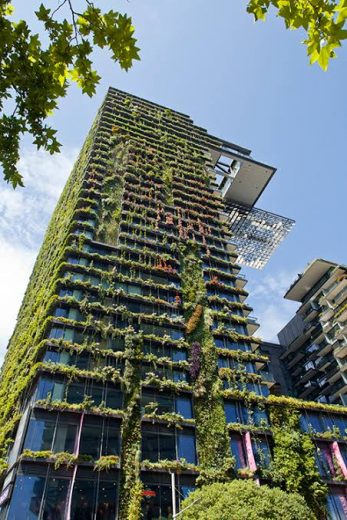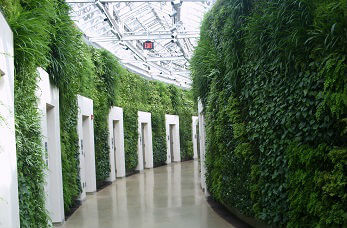Green building is a practice of construction which uses the processes responsible for environment friendly and efficient in resource usage through the life cycle of building starting from design, construction, operation, maintenance, renovation and till deconstruction process. In recent years, green architecture has attracted the attention of many contemporary architects and designers in the world. The aim of this concept is to increase green space in urban areas and greater efficiency in buildings especially in cities. It is a step for the survival of human interaction and environment which is derived from the concept of sustainable development in harmony with environmental compatibility to meet the needs of people.
Need for Green Building:
Maximum use of fossil energy and explosive growth of greenhouse gases are the main cause of global warming today. On the other hand, the increasing population of the world as a result of indiscriminate construction has faced cities with serious problems of air pollution. With the population growth, increasing development of cities and subsequent destruction of green spaces has increased the need to find ways to coexist with nature which will conserve energy, prevent land pollution, and reduce energy consumption. Now-a-days vertical housing has become the solution for fulfilling the housing need in urban areas. According to the World Green Building Council’s report, buildings contribute to 33% of carbon dioxide emission, 17% of water consumption, 25% of wood consumption, 30-40%of raw material consumption, and 40-50% of energy consumption in its construction process and operation. Therefore based on these facts, an environmentally sound construction and development should be considered to reduce the energy consumption. So the Green Building concept is being a trusted way to solve this issue. It is said that the building construction companies produce the second largest amount of greenhouse gases (30-40%) and demolition waste. The major energy consumption in building comes from modern lifestyle equipment like air-conditioning system, cooler, water heating to provide comfort to building occupants etc. These all add to pollution. Occupant activities also generate large amount of solid waste and water waste as well. As compared to a regular structure, a green building uses less energy, less water and other natural resources which create less waste and greenhouse gas and provides a healthy living place for people.

Fig 1: A vertical green building
Designing methods for Green Buildings:
To construct green buildings in the city, both vertical and horizontal green surfaces should be used. Vertical green surfaces include green walls, green facades, indoor and outdoor living green walls, Bio-Shades, Bio-Facades, vertical gardens etc. Horizontal green surfaces include roof garden and green roof.
- Green walls or vertical green surfaces: Green walls facilitate growth of agricultural plants. Vertical vegetation is implemented in the building structures. The plants are grown in a controlled pattern providing regular maintenance. Green walls are classified into two types of air purification: active and passive.
- Facade supported with green walls: This type of wall comprises steel, wood or plastic trellises that are externally attached to the building façade. Generally the climbing plants and the vines are supported with the help of horizontal, vertical or diagonal trellis members. In two dimensional façade system cables, ropes and meshes are employed. In the case of a three dimensional façade system, rigid frames and cages are employed. A cable system is used for maintenance of fast growing types of plants. On the other hand, a net system is used for the plants which grow slowly and need more support. Net system or network system is more flexible than cable system as net system has varied design capability.
- Interior and exterior living walls: living green walls create an alluring environment. They are equally impressive in appearance as they are purveyors of good health and life. Plants in the walls work as a natural air filtration system. The occupants can enjoy the green lush environment inside the building and soothing effects of it. The walls have different implementation details depending on the type of pages, types of exterior and interior. It is a more costly system as compared to green façade and needs more maintenance in terms of irrigation and supply of additives for plants.
- Green roof: Green roof is a segment of green building. It is represented by vegetative layer of the roof. Green roof consists of several layers like protective felt layer, drainage-storage foil, filtration layer and final layer of vegetation. Depending on the type of green roof, the types of vegetation, substrate and other layers may vary. The vegetation on the green roof keeps the surface cool and reduces heat from the air by evapotranspiration. This mechanism keeps the temperature of the roof surface and the surrounding air low. Green roofs help in absorbing negative radiation that comes from sunlight. It absorbs the harmful effects of pollutants. It reduces the use of electricity which is needed for heating and cooling the building, thereby saving the energy.

Fig 2: Interior living walls
Benefits of Green Building:
- Low maintenance and operation cost.
- Energy efficiency.
- Enhances indoor environment quality.
- Water quality and conservation.
- Sustainable site design.
- Minimize the use of material and resources.
- The air quality is improved.
- Aesthetic appeal.
- Deadening of sound.
Green Buildings in India:
The Confederation of Indian Industry (CII) formed a council on green building with an aim of bringing the green building movement in India to become one of the global leaders in green buildings by the year 2015. The council was named as Indian Green Building Council (IGBC). IGBC has developed green building rating programs to cover residential, commercial, factory buildings etc. Each rating system divided into different levels of certification are as follows:
- ‘Certified’ to recognize best green building practices.
- ‘Silver’ to recognize outstanding performance.
- ‘Gold’ to recognize national excellence.
- ‘Platinum’ to recognize global leadership.
At present IGBC has achieved significant milestones with the strong support from various stakeholders. There are 6287 projects registered with IGBC from various parts of India and abroad, amounting total footprint of 7.75 billion square feet. Some Green Building projects of India are Suzlon Energy Limited of Pune, Biodiversity Conservation India of Bangalore, Nokia- Gurgaon and Rajiv Gandhi International Airport of Hyderabad etc.
Conclusion:
Applying the green building concept can resolve national issues like energy efficiency. Making building sustainable will not only improve the standard of living but also will help the future generation of India to become healthier. Though practices and technologies employed in green building are constantly evolving and it may also differ from region to region. We should practice the green building techniques together to reduce and ultimately eliminate the impacts of building on environment and health.
If you have a query, you can ask a question here.


